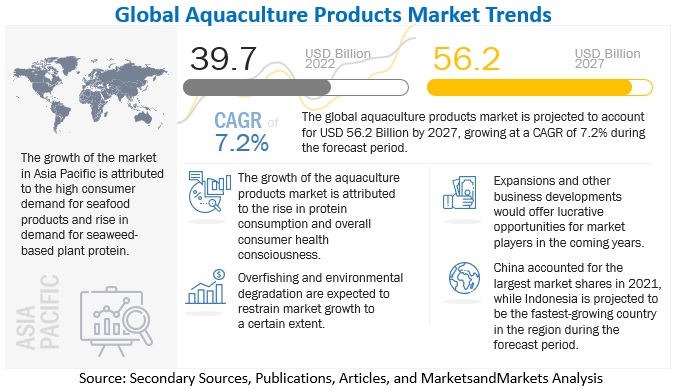The global aquaculture products market size is estimated to be valued at USD 39.7 billion in 2022. It is projected to reach USD 56.2 billion by 2027, recording a CAGR of 7.2% during the forecast period. Some macroeconomic and microeconomic elements that have been prevalent in some important countries have had an impact on the global aquaculture products market. In terms of value sales, this would be strong enough to significantly influence the market during the predicted period. The rise in consumer awareness, health consciousness, demand for a high-protein diet, changing lifestyles, and consumption patterns drive the demand in the aquaculture products market.

What are aquaculture products?
Aquaculture products refer to any organisms or products derived from the farming or cultivation of aquatic organisms, including fish, crustaceans, mollusks, algae, and aquatic plants. These products are produced in controlled environments such as ponds, tanks, or other artificial enclosures, as opposed to being caught in the wild. Aquaculture products can include:
1. Fish: Common species raised in aquaculture include salmon, tilapia, carp, trout, catfish, and seabream.
2. Crustaceans: Aquaculture also encompasses the farming of crustaceans such as shrimp, prawns, crayfish, and crabs.
3. : Mollusk aquaculture includes the cultivation of oysters, mussels, clams, scallops, and abalone.
4. Algae: Certain types of algae are cultivated for various purposes, including food supplements, biofuels, pharmaceuticals, and wastewater treatment.
5. Aquatic Plants: Aquatic plants such as seaweeds and various types of freshwater plants may be cultivated for food, animal feed, pharmaceuticals, cosmetics, and environmental purposes.
Aquaculture products play a significant role in meeting the increasing global demand for seafood and other aquatic products, contributing to food security, economic development, and environmental sustainability. However, aquaculture practices must be managed carefully to minimize environmental impacts and ensure the health and welfare of the farmed species.
Aquaculture Products Market Growth Drivers
The aquaculture products market has experienced significant growth in recent years, driven by several key factors:
1. Increasing Demand for Seafood: As global populations grow and dietary preferences shift towards healthier protein sources, there has been a surge in demand for seafood. Aquaculture provides a sustainable solution to meet this demand, as it allows for controlled breeding and harvesting of various aquatic species.
2. of Wild Fish Stocks: Overfishing has led to the depletion of many wild fish stocks, making aquaculture an essential means of supplementing seafood supply. Aquaculture helps alleviate pressure on wild fish populations by providing an alternative source of seafood.
3. Technological Advancements: Advances in aquaculture technology have improved production efficiency and reduced operational costs. Innovations such as automated feeding systems, water quality monitoring, and genetic breeding programs have increased yields and profitability for aquaculture operations.
4. Environmental Sustainability: Sustainable aquaculture practices have gained prominence as consumers and regulatory bodies prioritize environmental conservation. Responsible aquaculture methods, such as integrated multi-trophic aquaculture (IMTA) and recirculating aquaculture systems (RAS), minimize environmental impact by reducing waste discharge and conserving resources.
5. Support and Policies: Many governments worldwide are implementing policies to promote aquaculture development as part of their food security and economic growth strategies. Supportive measures include financial incentives, infrastructure development, and regulatory frameworks that encourage responsible aquaculture practices.
6. Health Benefits of Seafood: Growing awareness of the health benefits associated with consuming seafood, such as omega-3 fatty acids and lean protein, has driven increased consumption. Aquaculture provides a reliable source of safe and nutritious seafood products to meet consumer demand for healthy food choices.
7. Expansion of Aquaculture Species: The diversification of aquaculture species beyond traditional fish, such as shrimp, salmon, and tilapia, has expanded market opportunities. Cultivation of high-value species like oysters, mussels, and seaweed for niche markets further contributes to market growth.
8. Globalization and Trade Liberalization: Increasing globalization and trade liberalization have facilitated the expansion of aquaculture products into new markets. Improved transportation networks and trade agreements have enabled aquaculture producers to access international markets, driving market expansion and revenue growth.
What are the major challenges faced by the aquaculture industry?
The increase in the vegan population has led to a decline in fish consumption in recent years. Veganism is a lifestyle that seeks to exclude the use of animal products for ethical, environmental, or health reasons. As a result, many vegans do not consume fish or any other animal-based products, opting instead for plant-based sources of protein. This shift in consumer behavior has had a significant impact on the fishing industry, as demand for fish products has declined in many parts of the world. Additionally, the rise in awareness of the environmental impact of fishing has led to more people considering the sustainability of their food choices, which has contributed to the decline in fish consumption. As a result, the fishing industry has had to adapt to changing consumer preferences, and many fishing companies are now exploring alternative seafood products or sustainable fishing practices to address this trend.
Download PDF Brochure: https://www.marketsandmarkets.com/pdfdownloadNew.asp?id=2224024
Aquaculture Products Market Drivers: Increased health consciousness and environmental awareness
In recent years, there has been a significant increase in fishmeal consumption, driven by rising health consciousness and environmental awareness among consumers. Fishmeal, a protein-rich feed ingredient derived from wild fish, is considered an important component of many aquatic animal diets, including farmed fish, shrimp, and other aquaculture species. As people become more aware of the health benefits associated with consuming fish-based protein, such as improved cardiovascular health and weight management, demand for fishmeal as a dietary supplement has increased. Additionally, there is a growing awareness of the environmental benefits of consuming fishmeal as a feed ingredient, as it is a sustainable and renewable resource that supports the growth of the aquaculture industry while reducing the environmental impact associated with traditional livestock farming. As a result, fishmeal consumption is expected to continue to rise in the coming years, driven by an increasing demand for healthy and sustainable food sources.
Pharmaceuticals by rearing product type in the aquaculture products market is projected to grow at the highest CAGR during the forecast period
The market growth of pharmaceuticals used for aquatic animal health has been increasing in recent years. The demand for aquatic animal health products has been driven by the growing aquaculture industry, which has expanded rapidly in response to the increasing demand for seafood. The use of pharmaceuticals in aquaculture is critical in maintaining the health and welfare of aquatic animals, and preventing and treating diseases that can lead to significant economic losses. The aquaculture industry has witnessed the development of a variety of pharmaceutical products, including vaccines, antibiotics, probiotics, and parasiticides, which have improved the overall health and productivity of aquatic animals. Additionally, the growing concern for food safety and environmental sustainability has driven the development of new pharmaceuticals with fewer environmental impacts and residues in seafood products. As such, the market for pharmaceuticals used for aquatic animal health is expected to continue to grow in the future, driven by the increasing demand for sustainable and safe seafood products.
In 2022, FeedVax (Argentina) announced funding from Conservation International Ventures. The company is working on an oral vaccine that it claims will eliminate the need for animal handling, and it plans to start with tilapia farmers in Brazil.
Asia Pacific is estimated to dominate the aquaculture products market in 2022.
The Asia Pacific region has been experiencing significant growth in the aquaculture products market in recent years. This is due to several factors, including the region’s large population and increasing disposable income, which is driving demand for seafood. In addition, the Asia Pacific region has favorable geographic conditions for aquaculture, with a long coastline, large rivers, and favorable weather conditions. The region is the largest producer of aquaculture products globally, accounting for over 90% of global aquaculture production. China is the largest producer of aquaculture products in the region, followed by India, Indonesia, and Vietnam. In recent years, there has been a shift towards higher value aquaculture products, such as shrimp, salmon, and tilapia, driven by changing consumer preferences and increasing health consciousness. As a result, the aquaculture products market in the Asia Pacific region is expected to continue its growth trajectory, offering significant opportunities for investors and businesses in this industry.
Top Companies in the Aquaculture Products Market
1. Pentair PLC (US)
2. AKVA Group (Norway)
3. Xylem Inc. (US)
4. Aquaculture Equipment Ltd. (UK)
5. Aquaculture System Technologies LLC (US)
6. Pioneer Group (Taiwan)
7. CPI Equipment Inc. (Canada)
About MarketsandMarkets™
MarketsandMarketsTM has been recognized as one of America’s best management consulting firms by Forbes, as per their recent report.
MarketsandMarkets™ is a blue ocean alternative in growth consulting and program management, leveraging a man-machine offering to drive supernormal growth for progressive organizations in the B2B space. We have the widest lens on emerging technologies, making us proficient in co-creating supernormal growth for clients.
Earlier this year, we made a formal transformation into one of America’s best management consulting firms as per a survey conducted by Forbes.
The B2B economy is witnessing the emergence of $25 trillion of new revenue streams that are substituting existing revenue streams in this decade alone. We work with clients on growth programs, helping them monetize this $25 trillion opportunity through our service lines – TAM Expansion, Go-to-Market (GTM) Strategy to Execution, Market Share Gain, Account Enablement, and Thought Leadership Marketing.
Built on the ‘GIVE Growth’ principle, we work with several Forbes Global 2000 B2B companies – helping them stay relevant in a disruptive ecosystem. Our insights and strategies are molded by our industry experts, cutting-edge AI-powered Market Intelligence Cloud, and years of research. The KnowledgeStore™ (our Market Intelligence Cloud) integrates our research, facilitates an analysis of interconnections through a set of applications, helping clients look at the entire ecosystem and understand the revenue shifts happening in their industry.
Media Contact
Company Name: MarketsandMarkets™ Research Private Ltd.
Contact Person: Mr. Aashish Mehra
Email: Send Email
Phone: 18886006441
Address:630 Dundee Road Suite 430
City: Northbrook
State: IL 60062
Country: United States
Website: https://www.marketsandmarkets.com/Market-Reports/aquaculture-product-market-2224024.html

